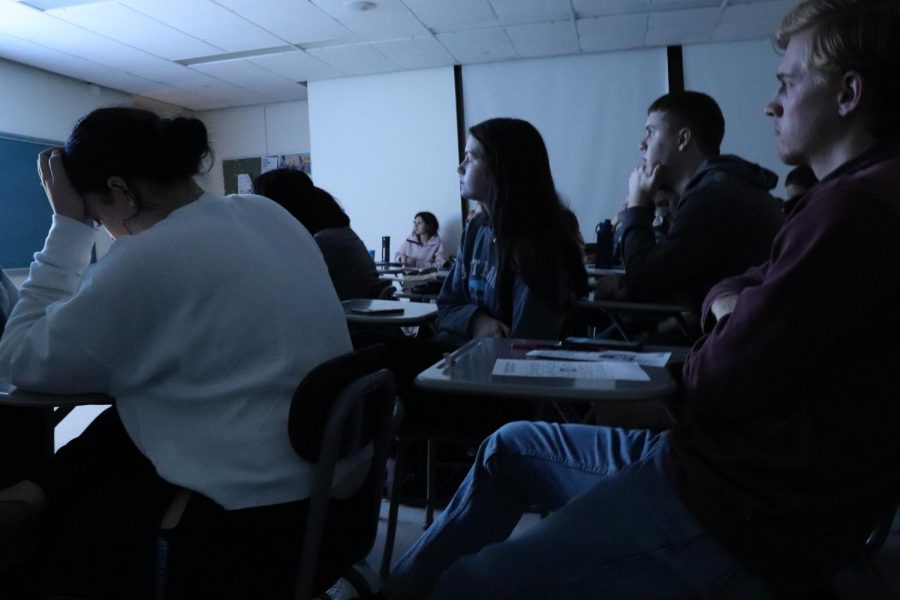On Oct. 15, a dozen Democratic candidates hoping to become the next president of the United States assembled on a debate stage in Ohio. At the University of Massachusetts, more than 50 students gathered in Herter Hall for a collective debate watch party hosted by Free the Facts.
The fourth Democratic primary debate for the 2020 election, hosted by CNN and the New York Times in Westerville, Ohio, featured an unprecedented 12 candidates in a three-hour-long back and forth moderated by CNN’s Anderson Cooper and Erin Burnett and the New York Times National Editor Marc Lacey.
The current front-runners, former Vice President Joe Biden, Massachusetts Sen. Elizabeth Warren and Vermont Sen. Bernie Sanders stood at the center podiums abutted by South Bend, Indiana Mayor Pete Buttigieg and California Sen. Kamala Harris. Flanking the ends of the stage were Hawaii Rep. Tulsi Gabbard and former Housing and Urban Development Secretary Julián Castro.
The other five candidates included New York entrepreneur Andrew Yang, former Texas Rep. Beto O’Rourke, Minnesota Sen. Amy Klobuchar, New Jersey Sen. Cory Booker and billionaire businessman Tom Steyer, in his first televised debate performance for this election.
“Finally, they’re all on one stage, but there’s not enough time for all of them to talk, it seems like,” said Lily Musengwa, a national exchange student from Arkansas Tech University who attended the watch party.
Both Musengwa, studying emergency management and cultural and geospatial studies originally, and fellow viewer Rebecca Gullotto, a sophomore legal studies major, agreed the unprecedented 12 candidates in one debate seemed like too many, perhaps best exemplified by the debate’s decision to not include opening or closing statements from hopefuls in an attempt to save time.
However, Musengwa, who currently has Buttigieg and Warren as her top two choices,noted that it’s also good that all the candidates are represented. “It’s better that they’re all there so they can call each other out,” she said.
“Once all of the people who know they don’t have as much of a shot drop out then, it’ll be easier to understand,” said Gullotto, who currently favors Warren. “Today she’s not doing so hot, but [the other candidates are] all attacking Warren and Biden and Sanders because they’re the top three.”
“Hopefully they’ll stop attacking each other too and like unite a little more,” Musengwa added.
To qualify for the debate candidates had to get two percent support in four approved polls by the Democratic National Committee and have 130,000 unique donors, according to Politico.
This was the first debate since Democrats opened a formal impeachment inquiry against President Donald Trump, the escalation of Turkey’s involvement against the Kurds in northern Syria after U.S. troop withdrawal and Sanders’ revelation that he suffered a heart attack on the campaign trail.
As the dozen Democrats duked it out on policies ranging from health care, to gun violence, the Supreme Court, the economy and the opioid epidemic, among other topics, students watched and reacted with occasional verbal one-liners or dispersed bursts of laughter to candidates’ responses.
Debate watchers also played along with bingo sheets about things that may happen in the debate and had the chance to win a gift card and were catered with pizza.
Junior political science major, Timothy Ennis, headed the watch party as UMass’ college ambassador for Free the Facts, a nonpartisan education nonprofit. Ennis is also the president of the UMass Democrats.
“[FTF does] a lot of non-partisan policy work and then they go on tours to college campuses because they saw that there’s really no one around campus to talk just about like the facts,” said Ennis. “It’s either you have some policy person or figurehead on the right or someone on the left just come, give like the party line and then stir up some controversy, but [FTF comes] in, they just lay out the numbers and some of the different ideas and kind of leave it to people to decide.”
Ven Gopal, the communications coordinator at FTF, explained by phone that the nonprofit has been involved at UMass the past three semesters. FTF has over 100 students in leadership programs in 25 states and the District of Columbia including at Smith College in Northampton.
The group focuses on topics such as social security, Medicare and pensions as well as a recent pilot testing on the student loan crisis, all specifically aimed at informing young Americans, according to Gopal.
By doing this, FTF hopes to restore discourse and bridge the divide on college campuses for students of different ideological backgrounds. Gopal added that FTF also brings policy experts from both sides of the aisle to universities to present facts, information and solutions to these issues, but not tell them what to think.
While this was the first watch party hosted by FTF since the 2016 election cycle according to Ennis, he wants to continue with more debate watch parties in the future.
“We’re hoping to keep doing this, either partnering with Free the Facts again or just doing it on our own and making it accessible for students to come out, have a good time and hopefully… bounce ideas off of each other during the commercial breaks,” he said.
“It’s a great draw and we’re happy to see so many people come out and be excited about just hearing from candidates and trying to dive into maybe a substantive policy conversation,” Ennis added.
The New York Times, the televised event’s co-host, also streamed the debate in its entirety online. All UMass students are eligible for a free subscription to the Times.
Chris McLaughlin can be reached at [email protected] and followed on Twitter @ChrisMcLJournal.




















